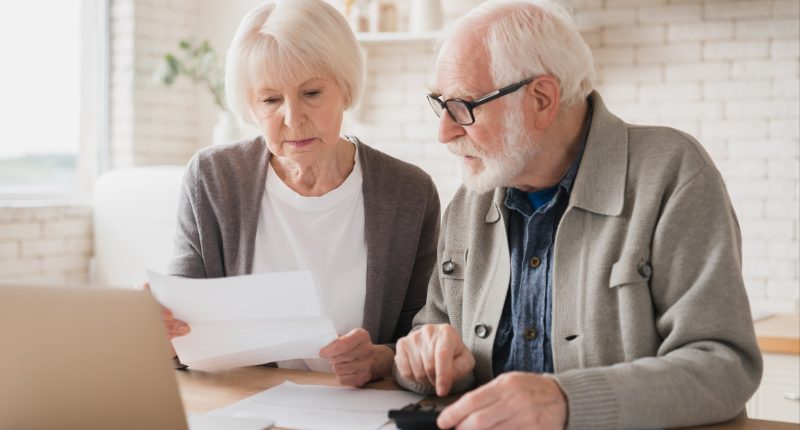UP to 900,000 retirees face paying tax on their state pension for the first time in their lives this year, new government figures reveal.
This is due to a combination of hefty state pension rises and frozen tax thresholds.
Those affected are low earners who use the marriage allowance to share their personal tax allowance with their spouse.
The scale of the issue was revealed in a freedom of information (FOI) request made by consultancy LCP, provided exclusively to The Sun.
According to the FOI, 40% of marriage allowance recipients are over 65 years old, equating to around 900,000 pensioners.
The marriage allowance lets one low-income partner transfer 10% of their personal tax allowance (£1,260) to their spouse if they have it spare, saving them up to £252 in tax a year.
MORE ON MONEY
While it could be either partner, the majority of marriage allowance claimants are women.
In the past, the personal allowance – currently £12,570 a year – has risen roughly in line with inflation and earnings, and so the state pension has generally stayed less than 90% of the personal allowance.
But tax thresholds including the personal allowance have been frozen at the same rate since April 2021.
The government freezes tax thresholds as a way to raise extra cash without directly increasing taxes, as wage rises caused by inflation drag more people into higher tax brackets.
Most read in Money
Over the same time frame, the state pension has increased significantly.
From April 2024, it will rise by 8.5% in line with September’s wage growth under the government’s triple lock guarantee, having already risen by 10.1% last year.
This means those claiming state pension and passing the remaining allowance to their partner now face having to pay tax for the first time in retirement.
This is because 90% of the personal allowance is £11,313. But the new state pension will be just over £11,500 a year from April.
So, if that partner continued to give 10% of their personal allowance to their spouse, they would breach their personal allowance.
Alternatively, if they stopped using the marriage allowance, their partner would have to pay an extra £252 in tax a year.
Former pensions minister Steve Webb, now partner at LCP, explained: “One of the unwelcome side-effects of the continued freezing of tax thresholds is that many married women may now face tax bills in retirement.
“They now have to make a rather messy choice between claiming back their tax allowance and increasing their husband’s tax bill, or getting an annual tax demand from HMRC.
“This could all be solved if the government ended the stealthy squeeze on family finances created by repeatedly freezing the tax-free allowance”.
The Sun contacted the Government for comment.
What do I do if I’m affected?
According to Mr Webb, many women will receive a tax bill of less than £252 a year, so they will be better off as a couple if they continue to use the marriage allowance.
This is because the higher income partner will automatically lose £252 to tax if they ditch the marriage allowance.
However, if you will lose the full £252 this year – for example, because you have some additional income – you simply need to decide which partner you would rather pay the bill.
“If couples leave things as they are, the low earner will get a letter from HMRC asking them to pay a small sum in tax each year, though for some it could mean paying up to £252,” Mr Webb said.
“Alternatively they can cancel the marriage allowance, saving the low earner from tax but costing their partner the full amount.”
You can check how much tax you will owe by visiting the government website.
You can cancel the marriage allowance online by signing into your Government Gateway account, or ring 0300 200 3300 to cancel it over the phone.
What is the marriage allowance and can I claim it?
The marriage allowance was introduced in April 2015 to allow low-earning married people to give up 10% of their personal tax allowance to their partner to make a small tax saving.
If you have an income of less than 90% of your personal allowance but your spouse has to pay tax, you could benefit from claiming it.
The maximum saving has been £252 since April 2021; before this it was £250.
You can backdate claims for marriage allowance for up to four years.
So, you can currently claim back to the 2019/2020 tax year onwards, even if your partner has died since then.
To backdate a claim, apply through your Government Gateway account or phone HMRC.
READ MORE SUN STORIES
To register for a Government Gateway account, you’ll need your National Insurance number and two of any of the following:
- a valid UK passport
- a UK photocard driving licence
- a payslip from the last three months, or a P60 from your employer
- details of a tax credit claim
- details from a self assessment tax return
- your credit record information
Do you have a money problem that needs sorting? Get in touch by emailing [email protected].
Plus, you can join our Sun Money Chats and Tips Facebook group to share your tips and stories.










